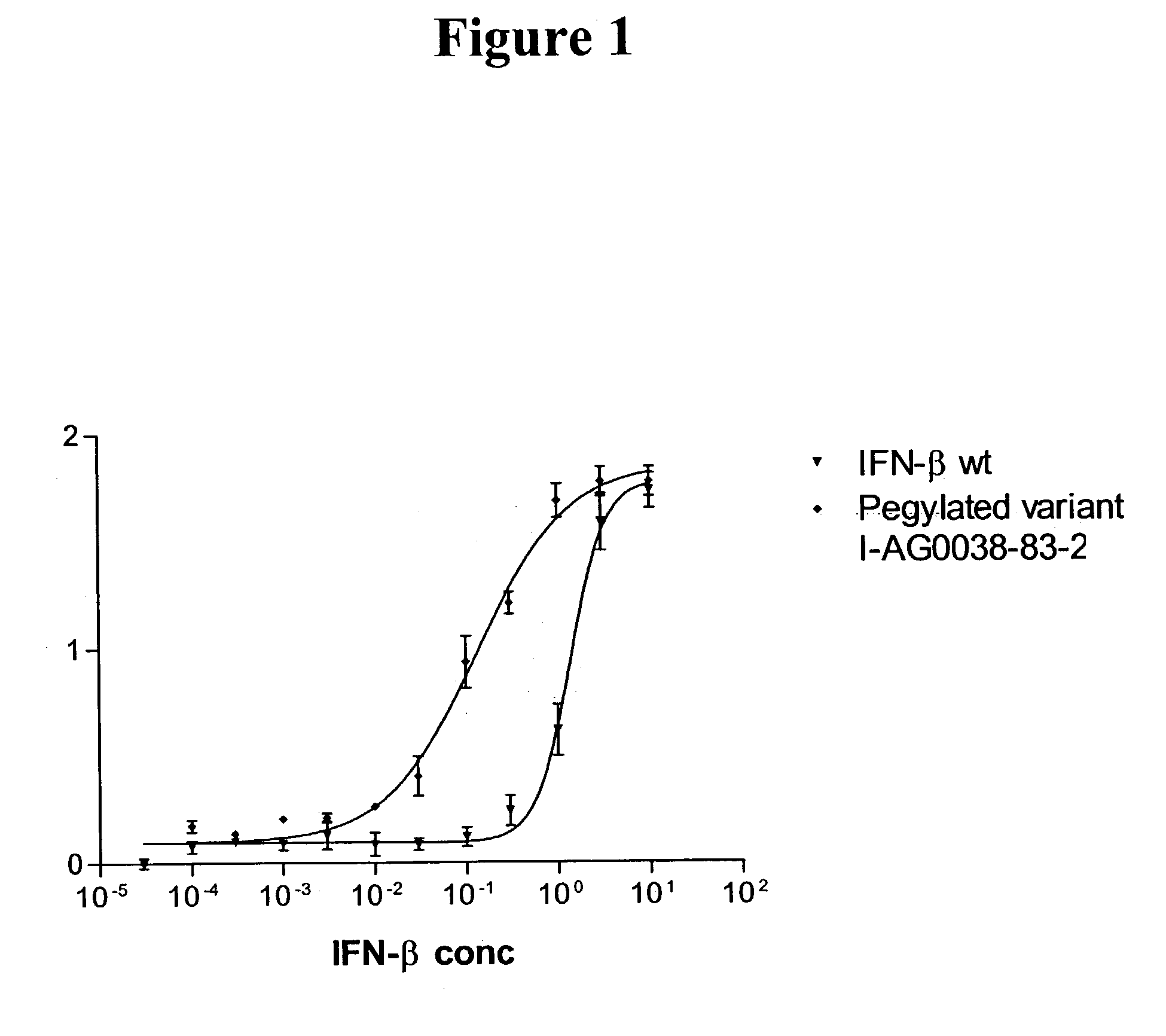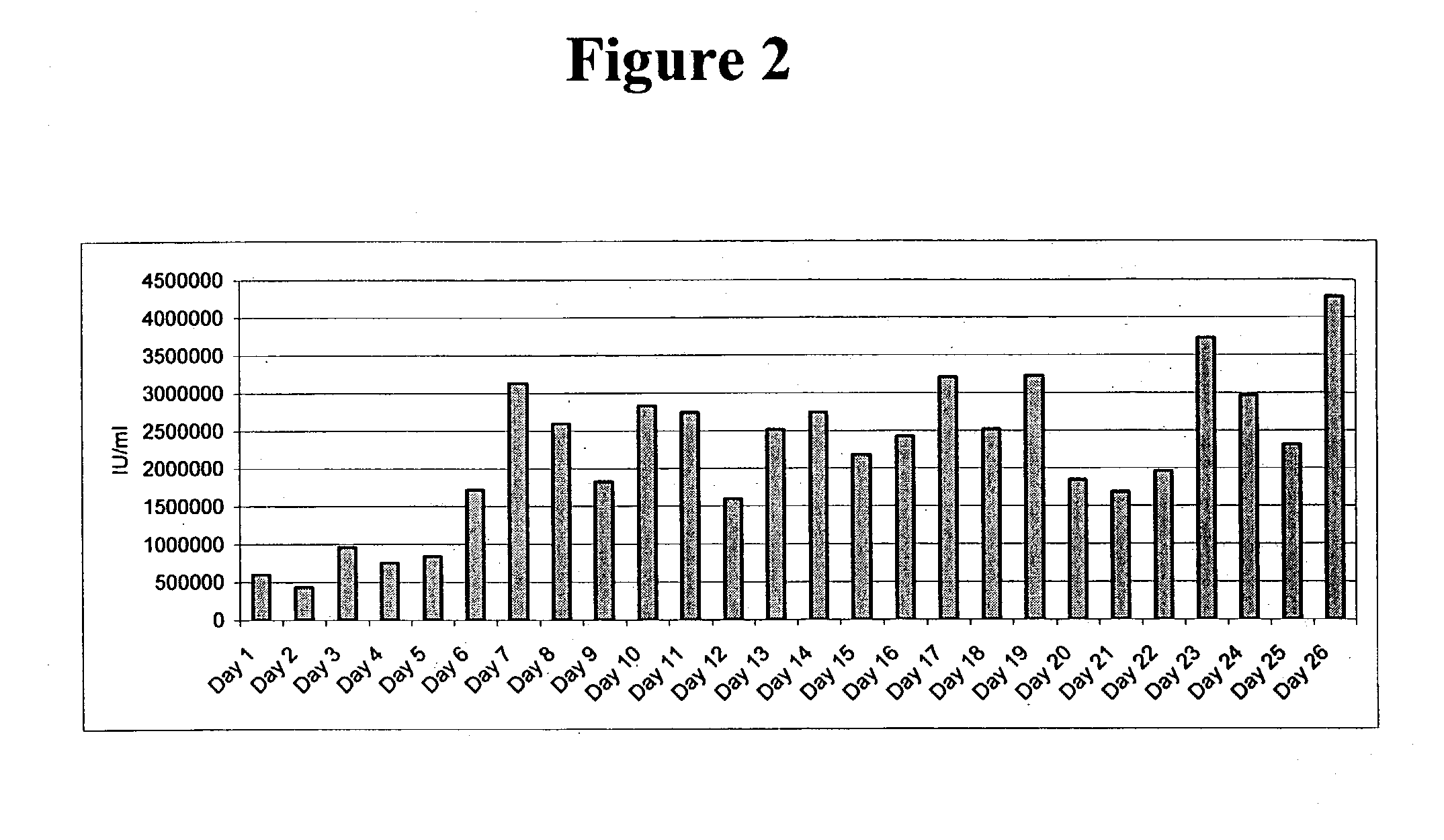Interferon-beta variants and conjugates
a technology of interferon and beta-beta, which is applied in the field of interferon beta-beta variants and conjugates, can solve problems such as the inability to achieve attachmen
- Summary
- Abstract
- Description
- Claims
- Application Information
AI Technical Summary
Benefits of technology
Problems solved by technology
Method used
Image
Examples
example 1
Design of an Expression Cassette for Expression of Interferon .beta. in Mammalian and Insect Cells
[0434] The DNA sequence, GenBank accession number M28622 (shown in SEQ ID NO 1), encompassing a full length cDNA encoding human interferon .beta. with its native signal peptide, was modified in order to facilitate high expression in mammalian cells. First the ATG start codon context was modified according to the Kozak consensus sequence (Kozak, M. J Mol Biol 1987 August 20;196(4):947-50), such that there is a perfect match to the consensus sequence upstream of the ATG start codon. Secondly the codons of the native human interferon .beta. was modified by making a bias in the codon usage towards the codons frequently used in highly expressed human genes. Subsequently, certain nucleotides in the sequence were substituted with others in order to introduce recognition sites for DNA restriction endonucleases (this allows for easier modification of the DNA sequence later). Primers were designe...
example 2
Expression of Human Interferon .beta. in a Baculorvirus / Insect Cell System
[0449] In order to express the synthetic gene, encoding human interferon .beta. harboured in pCBProF1 (described in example 1) in the baculovirus / insect cell system the gene was excised with NheI and XhoI and ligated into the transfer vector pBlueBac 4.5, which is included in the MaxBac 2.0 Transfection kit obtained from Invitrogen (San Diego, USA). All methods used for generation of recombinant baculovirus and expression in insect cells are described in the "MaxBac 2.0 Transfection and Expression Manual" included in the kit.
[0450] In brief, together with liniarized AcMNPV DNA (Bac-N-Blue DNA) pBlueBac 4.5-interferon .beta. CBProF1) was transfected into SF9 cells. 3 days post-transfection the transfection supernatant was harvested and a plaque assay with appropriate viral dilutions was prepared. Blue distinct plaques were visible after 7 days and 6 individual plaques were collected for propagation in a 6-well ...
example 3
Expression of Human Interferon .beta. in HEK293 Cells
[0461] In order to express the synthetic gene, encoding human interferon .beta., harboured by pCBProF1 (described in example 1), in HEK293 cells (ATCC Cat. No. CRL-1573) the gene was PCR-amplified with the two primers PBR 7 (5'-CGCGGATCCATATGACCAACAAGTGCCTG-3') (SEQ ID NO 28) and PBR 2 (5'-CGCGGATCCTTATCAGTTGCGCAG-3') (SEQ ID NO 29) and cloned into the BamHI site of pcDNA3.1 (-) (Invitrogen, USA) in correct orientation, giving the plasmid pPR9.
[0462] For transfection of the HEK293 cell line a T-25 culture flask was seeded to 50% confluency in DMEM medium (Life Technologies, USA) containing 10% FBS and incubated over night. By usage of FuGENE 6 Transfection Reagent (Roche, USA) pPR9 was transfected into the cells: To 95 .mu.l serum-free DMEM medium was added 5 .mu.l FuGENE 6 and 1.7 .mu.l (2 .mu.g) pPR9 and incubated at room temperature for 20 minutes. The transfection complex was then added drop-wise to the cells and the culture f...
PUM
| Property | Measurement | Unit |
|---|---|---|
| molecular weight | aaaaa | aaaaa |
| distances | aaaaa | aaaaa |
| distances | aaaaa | aaaaa |
Abstract
Description
Claims
Application Information
 Login to View More
Login to View More - R&D
- Intellectual Property
- Life Sciences
- Materials
- Tech Scout
- Unparalleled Data Quality
- Higher Quality Content
- 60% Fewer Hallucinations
Browse by: Latest US Patents, China's latest patents, Technical Efficacy Thesaurus, Application Domain, Technology Topic, Popular Technical Reports.
© 2025 PatSnap. All rights reserved.Legal|Privacy policy|Modern Slavery Act Transparency Statement|Sitemap|About US| Contact US: help@patsnap.com



